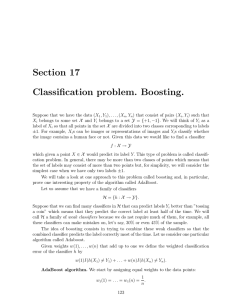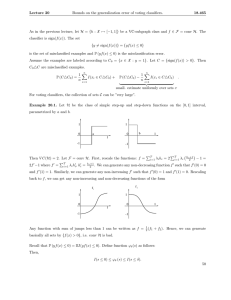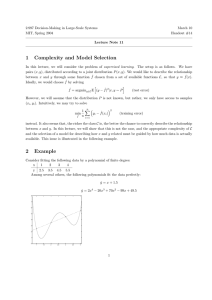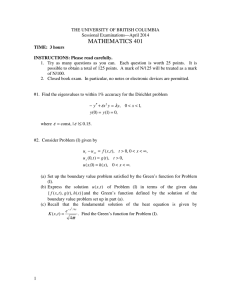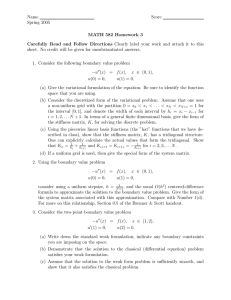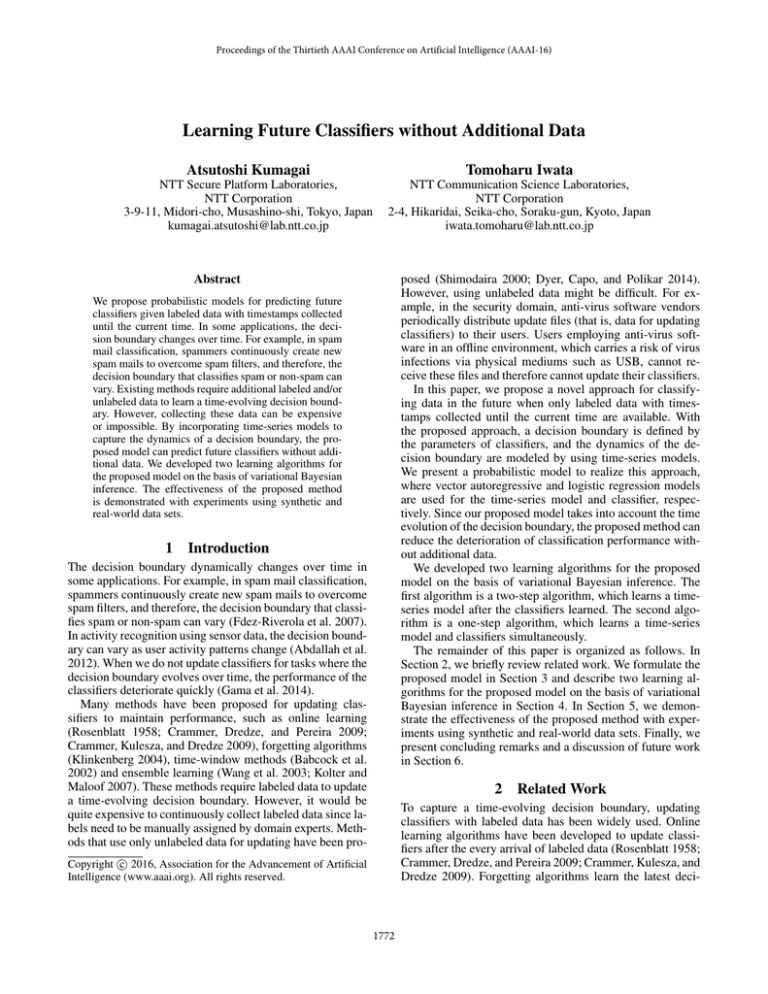
Proceedings of the Thirtieth AAAI Conference on Artificial Intelligence (AAAI-16)
Learning Future Classifiers without Additional Data
Atsutoshi Kumagai
Tomoharu Iwata
NTT Secure Platform Laboratories,
NTT Corporation
3-9-11, Midori-cho, Musashino-shi, Tokyo, Japan
kumagai.atsutoshi@lab.ntt.co.jp
NTT Communication Science Laboratories,
NTT Corporation
2-4, Hikaridai, Seika-cho, Soraku-gun, Kyoto, Japan
iwata.tomoharu@lab.ntt.co.jp
posed (Shimodaira 2000; Dyer, Capo, and Polikar 2014).
However, using unlabeled data might be difficult. For example, in the security domain, anti-virus software vendors
periodically distribute update files (that is, data for updating
classifiers) to their users. Users employing anti-virus software in an offline environment, which carries a risk of virus
infections via physical mediums such as USB, cannot receive these files and therefore cannot update their classifiers.
In this paper, we propose a novel approach for classifying data in the future when only labeled data with timestamps collected until the current time are available. With
the proposed approach, a decision boundary is defined by
the parameters of classifiers, and the dynamics of the decision boundary are modeled by using time-series models.
We present a probabilistic model to realize this approach,
where vector autoregressive and logistic regression models
are used for the time-series model and classifier, respectively. Since our proposed model takes into account the time
evolution of the decision boundary, the proposed method can
reduce the deterioration of classification performance without additional data.
We developed two learning algorithms for the proposed
model on the basis of variational Bayesian inference. The
first algorithm is a two-step algorithm, which learns a timeseries model after the classifiers learned. The second algorithm is a one-step algorithm, which learns a time-series
model and classifiers simultaneously.
The remainder of this paper is organized as follows. In
Section 2, we briefly review related work. We formulate the
proposed model in Section 3 and describe two learning algorithms for the proposed model on the basis of variational
Bayesian inference in Section 4. In Section 5, we demonstrate the effectiveness of the proposed method with experiments using synthetic and real-world data sets. Finally, we
present concluding remarks and a discussion of future work
in Section 6.
Abstract
We propose probabilistic models for predicting future
classifiers given labeled data with timestamps collected
until the current time. In some applications, the decision boundary changes over time. For example, in spam
mail classification, spammers continuously create new
spam mails to overcome spam filters, and therefore, the
decision boundary that classifies spam or non-spam can
vary. Existing methods require additional labeled and/or
unlabeled data to learn a time-evolving decision boundary. However, collecting these data can be expensive
or impossible. By incorporating time-series models to
capture the dynamics of a decision boundary, the proposed model can predict future classifiers without additional data. We developed two learning algorithms for
the proposed model on the basis of variational Bayesian
inference. The effectiveness of the proposed method
is demonstrated with experiments using synthetic and
real-world data sets.
1
Introduction
The decision boundary dynamically changes over time in
some applications. For example, in spam mail classification,
spammers continuously create new spam mails to overcome
spam filters, and therefore, the decision boundary that classifies spam or non-spam can vary (Fdez-Riverola et al. 2007).
In activity recognition using sensor data, the decision boundary can vary as user activity patterns change (Abdallah et al.
2012). When we do not update classifiers for tasks where the
decision boundary evolves over time, the performance of the
classifiers deteriorate quickly (Gama et al. 2014).
Many methods have been proposed for updating classifiers to maintain performance, such as online learning
(Rosenblatt 1958; Crammer, Dredze, and Pereira 2009;
Crammer, Kulesza, and Dredze 2009), forgetting algorithms
(Klinkenberg 2004), time-window methods (Babcock et al.
2002) and ensemble learning (Wang et al. 2003; Kolter and
Maloof 2007). These methods require labeled data to update
a time-evolving decision boundary. However, it would be
quite expensive to continuously collect labeled data since labels need to be manually assigned by domain experts. Methods that use only unlabeled data for updating have been pro-
2
Related Work
To capture a time-evolving decision boundary, updating
classifiers with labeled data has been widely used. Online
learning algorithms have been developed to update classifiers after the every arrival of labeled data (Rosenblatt 1958;
Crammer, Dredze, and Pereira 2009; Crammer, Kulesza, and
Dredze 2009). Forgetting algorithms learn the latest deci-
c 2016, Association for the Advancement of Artificial
Copyright Intelligence (www.aaai.org). All rights reserved.
1772
sion boundary by weighting training data with their age.
This weighting assumes that recent data are influential for
determining the decision boundary. Examples of weighting include linear decay (Koychev 2000), exponential decay
(Klinkenberg 2004), and time-window techniques that use
only training data obtained recently (Babcock et al. 2002).
Ensemble learning combines multiple classifiers to create a
better classifier (Wang et al. 2003; Kolter and Maloof 2007;
Brzezinski and Stefanowski 2014). Its mixture weight is
learned so that classifiers that capture a current decision
boundary well have a large weight. In some methods, active learning which is a algorithm for determine data should
be labeled is used for learning the time-evolving decision
boundary (Zhu et al. 2010; Zliobaite et al. 2014). Methods
for learning the boundary by using unlabeled data also have
been proposed (Zhang, Zhu, and Guo 2009; Dyer, Capo, and
Polikar 2014). All of these methods continuously require labeled and/or unlabeled data to capture the time-evolving decision boundary. However, the purpose of this study is to
predict classifiers for data obtained in the future without additional labeled and/or unlabeled data, and our task is separate from the areas where these methods should be applied.
A method for predicting future probability distribution
given data with timestamps collected until the current time
has been proposed (Lampert 2015). Although this method
predicts the future state of a time-varying probability distribution, our method predicts the future decision boundary.
Transfer learning utilizes data in a source domain to solve
a related problem in a target domain (Pan and Yang 2010;
Shimodaira 2000). Our task is a special case of transfer
learning, which considers data generated until a certain time
to be the source domain and data generated subsequently to
be the target domain where we cannot use the data in the
target domain for learning. Learning the dynamics of the decision boundary is considered to be learning the model for
transferring the decision boundaries in the source domain to
the decision boundary in the target domain.
3
Figure 1: Illustration of our approach.
our approach. The proposed model assumes that the posterior probability of label ynt given feature vector xtn is modeled by logistic regression as.
t
p(y t = 1|xt , w ) = σ(w xt ) = (1 + e−wt xn )−1 , (1)
n
n
t
t
n
where wt ∈ Rd is a parameter vector of the classifier ht ,
σ(·) is the sigmoid function, and denotes transposition.
Note that the posterior probability that ynt = 0, p(ynt =
0|xtn , wt ), is equal to 1 − p(ynt = 1|xtn , wt ).
We capture the dynamics of the classifier parameter wt by
using the vector autoregressive (VAR) model, which is one
of the classic time-series models (Lütkepohl 2005). The mth
order VAR model assumes that wt depends linearly on the
previous decision boundary wt−1 , . . . , wt−m as follows.
m
−1
wt ∼ N wt (2)
Ak wt−k + A0 , θ Id ,
k=1
where N (μ, Σ) is a normal distribution with mean μ and
covariance matrix Σ, A1 , . . . , Ak ∈ Rd×d are d × d matrices for defining dynamics, A0 ∈ Rd is a bias term, θ ∈ R+
denotes a hyper parameter, and Id represents an d × d identity matrix. In this paper, we restrict A1 , . . . , Ak ∈ Rd×d
to diagonal matrices for simplicity. This means the ith component of classifier parameter wt,i depends only on its own
previous parameter value wt−1,i , wt−2,i , · · · . Since the mth
order VAR model cannot be used as in case of t ≤ m, we assume that wt for t ≤ m is generated from N (wt |0, θ0−1 Id ).
The proposed model assumes that the dynamics and bias
parameter Ak for k = 0, . . . , m are generated from a normal distribution N (Ak |0, γk−1 Id ). The precision parameter
γk for k = 0, . . . , m is generated from a Gamma distribution, Gam(γk |ak , bk ), which is its conjugate prior. The precision parameters for dynamics θ and θ0 are generated from
Gam(θ|u, v) and Gam(θ0 |u0 , v0 ), respectively.
The joint distribution of labeled data D:={Dt }Tt=1 ,
classifier parameters W :=(w1 , . . . , wT ), dynamics and
bias parameters A:=(A0 , A1 , . . . , Am ), precision parameters Γ:=(γ0 , γ1 , . . . , γm ), θ and θ0 is written as:
p(D, W, A, Γ, θ, θ0 )
= p(D|W )p(W |A, θ, θ0 )p(A|Γ)p(Γ)p(θ)p(θ0 )
Proposed Model
First, we introduce notations and define the task studied in
t
this paper. Let Dt :={(xtn , ynt )}N
n=1 be a set of training data
t
collected at time t, where xn ∈ Rd is the d-dimensional
feature vector of the nth sample at time t, ynt ∈ {0, 1} is
its class label, and Nt is the number of training data collected at time t. We discretize time at regular intervals, and
data collected in the same time unit are regarded as data in
t Nt
t
the same time. We denote Xt :={xtn }N
n=1 and Yt :={yn }n=1 .
d
Our goal is to find classifiers ht : R → {0, 1}, t ∈
{T + 1, T + 2, . . . }, which can precisely classify data at
time t, given a set of training data D:={Dt }Tt=1 .
Next, we propose a probabilistic model for predicting future classifiers. Figure 1 illustrates our approach. Using labeled data from time 1 to T , the decision boundary for each
time, which is defined by classifier ht , and the dynamics
of the decision boundary are learned. Then, the decision
boundary in the future t = T + 1, T + 2, . . . is predicted
by using the learned decision boundary and dynamics.
We explain the proposed probabilistic model that realizes
=
Nt
T t=1 n=1
1773
p(ynt |xtn , wt ) ·
m
t=1
N (wt |0, θ0−1 Id )
×
×
T
t=m+1
m
N
m
wt Ak wt−k + A0 , θ−1 Id
In this paper, the variational posterior q(A, Γ, θ) is assumed
to factorize as follows.
m
q(Ak )q(γk )q(θ).
(7)
q(A, Γ, θ) =
k=1
N (Ak |0, γk−1 Id ) · Gam(γk |ak , bk )
k=0
k=0
× Gam(θ|u, v) · Gam(θ0 |u0 , v0 ).
By calculating the derivatives of the lower bound (6) with
respect to q(Ak ), q(γk ) and q(θ), we find that each distribution of (7) has the following functional form.
(3)
Since our model takes into account the time development of
the classifier parameter, our method improves the classification performance in a non-stationary environment. Note that
though we employ the logistic regression model and the vector autoregressive model for describing our proposed model,
it is possible to use other models such as boosting (Freund,
Schapire, and others 1996) and Gaussian processes (Roberts
et al. 2013).
4
where αk ∈ R is a diagonal vector (Ak1 , . . . , Akd ) of Ak ,
μk ∈ Rd , S k ∈ Rd×d , and aγk , bγk , uθ , v θ ∈ R+ . These
parameters are expressed as
γ
a0
uθ
S0 =
Id ,
+
(T
−
m)
bγ0
vθ
T
m
θ −1 u
dg(μk )wt−k ,
wt −
μ0 = S 0 θ
v t=m+1
k=1
Sk =
Two-step Learning Algorithm
aγk
Id
bγk
+
uθ
vθ
T
dg(wt−k )2 ,
t=m+1
⎞
⎛
T
θ u
μk = S −1
dg⎝wt −
dg(μl )wt−l −μ0⎠wt−k ,
k
v θ t=m+1
l=k
1
aγk = ak + d,
2
1
bγk = bk + (μk 2 + Tr(S −1
k )),
2
k = 1, . . . , m,
1
uθ = u + (T − m)d,
2
T
m
1 vθ = v +
(wt −
dg(μl )wt−l − μ0 2
2 t=m+1
(4)
Classifier parameters W are obtained by repeating this procedure from w1 to wT , where w0 is a zero vector 0.
Next, we learn the time-series model on the basis of variational Bayesian inference. Using learned classifier parameters W as observed data, we consider the following joint
distribution instead of (3).
l=1
+ Tr(S −1
0 )+
m
−1
w
t−l S l w t−l ),
(9)
l=1
where dg(x) returns a diagonal matrix whose diagonal elements are x = (x1 , . . . , xd ), · is 2 -norm, and Tr represents the trace. In variational Bayesian inference, the variational posterior (7) is calculated by updating the variables in
(8) by using equations (9) until some convergence criterion
are satisfied.
p(W, A, Γ, θ) = p(W |A, θ)p(A|Γ)p(Γ)p(θ)
m
T
−1
=
N wt Ak wt−k + A0 , θ Id
×
(8)
d
We explain the two-step algorithm. First, classifier parameters wt is learned for each time t by the maximizing a posteriori estimation. Since dynamics parameters are unknown,
we assume that the mean of the classifier parameters wt is
the parameters at the previous time wt−1 , p(wt |wt−1 , θ) =
N (wt |wt−1 , θ−1 Id ). Then, the log posterior to be maximized is as follows.
t=m+1
m
k = 0, · · · , m,
q(θ) = Gam(θ|u , v ),
Inference
log p(wt |Xt , Yt , wt−1 , θ)
= log p(Yt |wt , Xt ) + log p(wt |wt−1 , θ).
k = 0, · · · , m,
Gam(γk |aγk , bγk ),
θ θ
q(γk ) =
We developed two learning algorithms for the proposed
model on the basis of variational Bayesian inference (Bishop
2006). The first algorithm is a two-step algorithm, which
learns a time-series model after the classifiers learned. The
second algorithm is a one-step algorithm, which learns a
time-series model and classifiers simultaneously.
4.1
q(αk ) = N (αk |μk , S −1
k ),
k=1
N (Ak |0, γk−1 Id ) · Gam(γk |ak , bk ) · Gam(θ|u, v).
4.2
k=0
(5)
One-step Learning Algorithm
With the one-step algorithm, we learn the time-series model
and classifiers simultaneously.
The lower bound L(q) of the log marginal likelihood of
the proposed model is expressed as:
We obtain an approximate posterior distribution q(A, Γ, θ),
called the variational posterior, of the posterior distribution
p(A, Γ, θ|W ) since analytically calculating p(A, Γ, θ|W )
is impossible. It is known that the variational posterior
q(A, Γ, θ) is a local maximum point of the following lower
bound.
p(W, A, Γ, θ)
dAdΓdθ.
(6)
L(q) = q(A, Γ, θ) log
q(A, Γ, θ)
L(q) =
p(D, W, A, Γ, θ, θ0 )
q(W, A, Γ, θ, θ0 )log
dWdAdΓdθdθ0 .
q(W, A, Γ, θ, θ0 )
(10)
1774
1
uθ = u + (T − m)d,
2
T
m
1 −1
−1
vθ = v +
{Tr(S −1
η
t−l S l η t−l
0 +Λt )+
2t=m+1
We assume that the variational posterior q(W, A, Γ, θ, θ0 ) is
factorized as follows.
q(W, A, Γ, θ, θ0 )
=
T d
q(wt,i )
t=1 i=1
m
l=1
q(Ak )q(γk )q(θ)q(θ0 ).
(11)
+ η t −
k=0
m
dg(μl )η t−l − μ0 2
l=1
We would like to maximize the lower bound (10) in a similar
manner to the two-step algorithm. However, p(ynt |xtn , wt )
cannot be calculated analytically because of its nonlinearity.
To deal with this problem, we use the following inequality
based on (Jaakkola and Jordan 2000).
t
p(ynt |xtn ,wt ) ≥ −eyn a σ(ξnt )
+
m
−1 −1
Tr(dg(μl )2 Λ−1
t−l ) + Tr(S l Λt−l )},
l=1
1
1
uθ0 = u0 + md, v θ0 = v0 +
η 2 +Tr(Λ−1
t ),
2
2 t=1 t
T
a + ξnt
2
+ h(ξnt )(a2 − ξnt ) ,
2
(12)
t
K1
uθ Λt = θ
(dg(μm−t+l )2 + S −1
m−t+l )
v
l=1
Nt
u
+ θ0 Id + 2
h(ξnt )dg(xtn )2 ,
v
n=1
⎛
K1t
θ −1 ⎝ u
= λt,i
(ηm+l,i − μ0,i )μm+l−t,i
vθ
θ0
t
t
where a:=w
t xn , ξn ∈ R is a parameter that is associated
with each training data (xtn , ynt ) and determines
the accu
racy of the approximation, and h(ξnt ) := 2ξ1t σ(ξnt ) − 12 .
n
By substituting the term on the right side of (12) to the lower
bound L(q), we obtain a new lower bound L(q, ξ). Note that
since L(q) ≥ L(q, ξ) for all q and ξnt , increasing the value
of L(q, ξ) leads to an increased value of L(q). By calculating the derivatives of L(q, ξ) with respect to q(wt,i ), q(Ak ),
q(γk ), q(θ), q(θ0 ), and ξnt , we find that the variational posterior becomes as follows.
q(wt,i ) = N (wt,i |ηt,i , λ−1
t,i ),
ηt,i
l=1
−
k = 0, . . . , m,
q(γk ) = Gam(γk |aγk , bγk ),
k = 0, . . . , m,
l=i
Nt
uθ
u θ −1
2
)
+S
I
+2
h(ξnt )dg(xtn )2,
dg(μ
+
d
l
l
vθ
vθ
n=1
l=1
⎛
t
K
m
2
θ uθ ⎝u
= λ−1
μ
η
+
(ηt+l,i − μ0,i )μl,i
l,i
t−l,i
t,i
vθ
vθ
Λt =
(13)
l=1
−
θ
aγ0
u
Id ,
γ + (T − m) θ
b0
v
T
m
θ −1 u
ηt −
μ0 = S 0 θ
dg(μk )η t−k ,
v t=1
+
k=1
K2t m
θ u
vθ
Nt
l=1
ηt+l−l ,i · μl ,i · μl,i +
l=1 l =l
1
{(ynt − )xtn,i − 2h(ξnt )
2
n=1
uθ
μ0,i
vθ
⎞
ηt,l xtn,l xtn,i }⎠ ,
l=i
t = m + 1, . . . , T,
T
aγ
uθ S k = γk Id + θ
dg(η t−k )2 + Λ−1
t−k ,
bk
v t=m+1
⎞
⎛
T
θ u
μk = S −1
dg⎝η t −
dg(μl )η t−l −μ0⎠η t−k ,
k
v θ t=m+1
−1
t
(ξnt )2 = xt
n (Λt +η t η t )xn , t = 1, . . . , T,
i = 1, . . . , d,
n = 1, . . . , Nt
(14)
where η t := (ηt,1 , . . . , ηt,d ), μt := (μt,1 , . . . , μt,d ),
Λt := dg(λt,1 , . . . , λt,d ), K1t := min(t, T − m), and
K2t := min(m, T − t). We calculate the variational posterior (11) by updating the variables in (13) in turn via the
equations (14) until some convergence criterion are satisfied.
Finally, we can predict the classifier parameters wt for
t = T + 1, T + 2, . . . using the learned VAR model (2).
l=k
1
aγk = ak + d,
2
i = 1, . . . , d,
K2t
ηt,i
S0 =
ηm+l−l ,i · μl ,i · μm+l−t,i
l=1 l =m+l−t
t = 1, . . . , m,
where ηt,i ∈ R, λt,i , aγk , bγk , uθ , v θ , uθ0 , v θ0 ∈ R+ , μk ∈ Rd
and S k ∈ Rd×d . These parameters are determined by
m
⎞
1
+
{(ynt − )xtn,i − 2h(ξnt )
ηt,l xtn,l xtn,i }⎠,
2
n=1
q(θ) = Gam(θ|uθ , v θ ),
q(θ0 ) = Gam(θ0 |uθ0 , v θ0 ),
u
vθ
Nt
t = 1, . . . , T, i = 1, . . . , d,
q(αk ) = N (αk |μk , S −1
k ),
K1t
θ 1
bγk = bk + (μk 2 + Tr(S −1
k )),
2
k = 1, . . . , m,
1775
Table 1: Average and standard error of AUC over entire test time units. Values in boldface are statistically better than the others
(in paired t-test, p=0.05)
Proposed (two-step)
0.942±0.018
0.988±0.010
0.925±0.005
0.850±0.020
Gradual
Drastic
ELEC2
Chess.com
Proposed (one-step)
0.967±0.010
1.000±0.000
0.925±0.005
0.852±0.019
Batch
0.512±0.062
0.400±0.070
0.915±0.005
0.850±0.018
(a) Gradual
Online
0.632±0.058
0.407±0.066
0.904±0.006
0.837±0.018
Present
0.930±0.021
0.459±0.055
0.898±0.007
0.834±0.018
(b) Drastic
Figure 2: Average and standard error of AUC for each test time unit over ten runs.
5
Experiments
5.3
In our experiments, to find time variations in the performance of each method, we evaluated AUC by using data
until a certain time unit for training, and the remaining for
testing. For synthetic data sets, we created ten different sets
every synthetic data set. We set T = 10 and the remaining
ten time units as test data. For ELEC2, we set two weeks
as one time unit, and then T = 29 and the remaining ten
time units as test data. For Chess.com, we set 20 games as
one time unit, T = 15 and the remaining ten time units for
test data. For the real-world data sets, we chose 80% of instances randomly every time unit to create different training
sets (five sets) and evaluated the average AUC by using these
sets.
To demonstrate the effectiveness of the proposed method,
we compared it with several methods: online logistic regression (online), batch logistic regression (batch) and present
logistic regression (present). Batch learns a classifier by using all training data D at once. Online learns a classifier by
maximizing the log posterior (4) in turn from w1 to wT .
Present is a method that learns a classifier with only recent training data DT . We chose the regularization parameter for these three methods from {10−1 , 1, 101 } in terms
of which average AUC over the entire test periods was the
best. With the proposed method, we set the hyperparameters
as ak = u = u0 = 1, bk = v = v0 = 0.1 for all data sets
and fixed m as 3 for the real-world data sets from preliminary experiments. In addition, the regularization parameter
for the two-step algorithm was set to the same value for online.
We conducted experiments using two synthetic and two realworld data sets to confirm the effectiveness of the proposed
method.
5.1
Synthetic Data
We used two synthetic data sets. A sample (x1 , x2 ) ∈ R2
with label y ∈ {0, 1} and time t was generated from the
following distribution p(x|y, t).
x1 = 4.0 · cos(π(t/r + 1 − y)) + 1 ,
x2 = 4.0 · sin(π(t/r + 1 − y)) + 2 ,
(15)
where i for i = 1, 2 is a random variable with a standard
normal distribution. We can generate various data sets by
changing the value of r. Note that the data sets generated
by (15) have periodicity (a period is equal to 2r). Gradual
is a data set obtained with r = 20. The decision boundary
of this data gradually changed. Drastic is a data set obtained
with r = 2. The decision boundary of this data drastically
changed. In this experiments, we changed t from 1 to 20 and
generated 100 samples for each label y and each time t.
5.2
Setting
Real-world Data
We used two real-world data sets: ELEC2 and Chess.com.
Both data sets are public benchmark data sets for evaluating stream data classification or concept drift. ELEC2 contains 45312 instances and has eight features. Chess.com
contains 573 instances and has seven features. For details
on these data sets, refer to the paper (Gama et al. 2014).
In ELEC2, we removed instances that have missing values
since missing values are not the focus of our task. We removed instances with draw labels in Chess.com. As a result,
there were 27549 instances for ELEC2 and 503 instances for
Chess.com.
5.4
Results
Table 1 shows averages and standard errors of AUC over the
entire test time units for all data sets. For all data sets, the
proposed method (especially one-step) achieved the highest
AUC. This result means that the proposed method captured
1776
(a) two-step learning algorithm
(b) one-step learning algorithm
Figure 3: Average and standard error of AUC with the proposed method for each test time unit over ten runs.
(a) ELEC2
(b) Chess.com
Figure 4: Average and standard error of AUC for each test time unit over five runs.
a time-evolving decision boundary better compared with the
others.
Figure 2 shows the averages and standard errors of AUC
for each test time unit in the synthetic data sets. For Gradual,
the AUC of batch and online rapidly decreased over time
since these methods do not have a mechanism to capture
the time change of a decision boundary. However, the proposed method relatively maintained the classification performance. For Drastic, the AUC of the proposed method was
almost one at every time, though the AUC of batch, online,
and present unsteadily varied from zero to one over time.
We confirmed that the proposed method can work in a nonstationary environment effectively.
Figure 3 shows how the performance of the proposed
method changes against the hyperparameter m with Gradual. The AUC of the proposed method was improved by increasing the value of m. This is because the proposed model
become more flexible by increasing the values of m.
Figure 4 shows the averages and standard errors of AUC
for each test time unit in the real-world data sets. The
proposed method outperformed the others expect t=6 in
ELEC2. For Chess.com, the proposed method achieved the
highest AUC until t=4. However, there was not much difference from the others after t=5. In general, it is known that
long-time prediction is a very difficult task in time-series
analysis. Thus, this result is in accordance with this fact.
Long-time prediction is a future challenge.
We compared the proposed two-step algorithm and proposed one-step one with ELEC2. Figure 5 shows the averages and standard errors of AUC with different numbers
of training data at time t. Here, we used the same hyperparameters used before. One-step provided better classification
performance than did two-step when the number of training
Figure 5: Average and standard error of AUC by the proposed method with different numbers of training data.
data was small. Since two-step learns the time-series model
after the classifiers learned, the parameters of the time-series
model are sensitive to the learned classifiers, which are difficult to learn with a small number of training data. In comparison, one-step learned the classifiers and a time-series model
simultaneously and therefore become more robust.
6
Conclusion and Future Work
We proposed probabilistic models for predicting future classifiers given labeled data with timestamps collected until
the current time. We developed two learning algorithms for
the proposed model on the basis of variational Bayesian
inference. In experiments, we confirmed that the proposed
method can reduce the deterioration of the classification
ability better compared with existing methods. As future
work, we will apply a non-linear time-series model to the
proposed framework for data’s dynamics is non-linear.
1777
References
Pan, S. J., and Yang, Q. 2010. A survey on transfer learning. Knowledge and Data Engineering, IEEE Transactions
on 22(10):1345–1359.
Roberts, S.; Osborne, M.; Ebden, M.; Reece, S.; Gibson, N.;
and Aigrain, S. 2013. Gaussian processes for time-series
modeling. Philosophical Transactions of the Royal Society
of London A: Mathematical, Physical and Engineering Sciences 371(1984):20110550.
Rosenblatt, F. 1958. The perceptron: a probabilistic model
for information storage and organization in the brain. Psychological Review 65(6):386.
Shimodaira, H. 2000. Improving predictive inference under covariate shift by weighting the log-likelihood function.
Journal of Statistical Planning and Inference 90(2):227–
244.
Wang, H.; Fan, W.; Yu, P. S.; and Han, J. 2003. Mining
concept-drifting data streams using ensemble classifiers. In
Proceedings of the Ninth ACM SIGKDD International Conference on Knowledge Discovery and Data Mining, 226–
235. ACM.
Zhang, P.; Zhu, X.; and Guo, L. 2009. Mining data streams
with labeled and unlabeled training examples. In Data Mining, 2009, ICDM’09, Ninth IEEE International Conference
on, 627–636. IEEE.
Zhu, X.; Zhang, P.; Lin, X.; and Shi, Y. 2010. Active learning from stream data using optimal weight classifiers ensemble. Systems, Man, and Cybernetics, Part B: Cybernetics,
IEEE Transactions on 40(6):1607–1621.
Zliobaite, I.; Bifet, A.; Pfahringer, B.; and Holms, G.
2014. Active learning with drifting streaming data. Neural Networks and Learning Systems, IEEE Transactions on
25(1):27–39.
Abdallah, Z. S.; Gaber, M. M.; Srinivasan, B.; and Krishnaswamy, S. 2012. Streamar: incremental and active learning with evolving sensory data for activity recognition. In
Tools with Artificial Intelligence (ICTAI), 2012 IEEE 24th
International Conference on, volume 1, 1163–1170. IEEE.
Babcock, B.; Babu, S.; Datar, M.; Motwani, R.; and Widom,
J. 2002. Models and issues in data stream systems. In
Proceedings of the Twenty-first ACM SIGMOD-SIGACTSIGART Symposium on Principles of Database Systems, 1–
16. ACM.
Bishop, C. M. 2006. Pattern recognition and machine learning. springer.
Brzezinski, D., and Stefanowski, J. 2014. Reacting to different types of concept drift: The accuracy updated ensemble
algorithm. Neural Networks and Learning Systems, IEEE
Transactions on 25(1):81–94.
Crammer, K.; Dredze, M.; and Pereira, F. 2009. Exact convex confidence-weighted learning. In Advances in Neural
Information Processing Systems, 345–352.
Crammer, K.; Kulesza, A.; and Dredze, M. 2009. Adaptive regularization of weight vectors. In Advances in Neural
Information Processing Systems, 414–422.
Dyer, K. B.; Capo, R.; and Polikar, R. 2014. Compose:
A semisupervised learning framework for initially labeled
nonstationary streaming data. Neural Networks and Learning Systems, IEEE Transactions on 25(1):12–26.
Fdez-Riverola, F.; Iglesias, E. L.; Dı́az, F.; Méndez, J. R.;
and Corchado, J. M. 2007. Applying lazy learning algorithms to tackle concept drift in spam filtering. Expert Systems with Applications 33(1):36–48.
Freund, Y.; Schapire, R. E.; et al. 1996. Experiments with a
new boosting algorithm. In ICML, volume 96, 148–156.
Gama, J.; Žliobaitė, I.; Bifet, A.; Pechenizkiy, M.; and
Bouchachia, A. 2014. A survey on concept drift adaptation.
ACM Computing Surveys (CSUR) 46(4):44.
Jaakkola, T. S., and Jordan, M. I. 2000. Bayesian parameter
estimation via variational methods. Statistics and Computing 10(1):25–37.
Klinkenberg, R. 2004. Learning drifting concepts: Example
selection vs. example weighting. Intelligent Data Analysis
8(3):281–300.
Kolter, J. Z., and Maloof, M. A. 2007. Dynamic weighted
majority: An ensemble method for drifting concepts. The
Journal of Machine Learning Research 8:2755–2790.
Koychev, I. 2000. Gradual forgetting for adaptation to concept drift. Proceedings of ECAI 2000 Workshop on Current
Issues in Spatio-Temporal Reasoning,.
Lampert, C. H. 2015. Predicting the future behavior of a
time-varying probability distribution. In Proceedings of the
IEEE Conference on Computer Vision and Pattern Recognition, 942–950.
Lütkepohl, H. 2005. New introduction to multiple time series analysis. Springer Science & Business Media.
1778


